
Unlock Movement: A Guide to Physical Activity Training for Neurorehabilitation Professionals
"Empowering Healthcare Providers with Behavior Change Strategies for Enhanced Patient Outcomes."
Increasing physical activity (PA) is a cornerstone of health, yet it remains a challenge, especially for individuals with neurological conditions. While the benefits of exercise for neurological rehabilitation are clear—influencing neurotrophic, neuroprotective, and disease-modifying effects—simply advising patients to be more active isn't enough.
For those with neurological disabilities, physical limitations and cognitive impairments can make regular physical activity difficult. That’s where behavior change strategies (BCS) come in, offering techniques specifically designed to address the psychological factors that influence behavior. Unfortunately, many healthcare professionals (HCPs) lack the confidence and understanding to effectively implement these strategies.
This article explores findings from a systematic review aimed at understanding the methods used to train HCPs in delivering BCS for PA promotion in neurological populations. By examining how previous behavior change intervention studies have trained HCPs, we can inform the design of future training programs and bridge the gap between knowledge and clinical implementation.
Why Behavior Change Strategies Matter in Neurorehabilitation?

Behavior change strategies are the active components of interventions designed to modify behavior by targeting psychological determinants. In neurorehabilitation, effective strategies include tailored counseling with goal setting, planning, monitoring, and feedback. Guidelines and systematic reviews emphasize that combining PA initiatives with BCS is most effective, yet this approach is not consistently applied.
- Search Strategy: Eight databases were searched for articles describing HCP training on BCS targeting PA and/or exercise for neurological pathology.
- Study Selection: Two researchers independently screened abstracts, using third-party consensus when needed. Studies had to describe the planning/implementation of BCS targeting PA in adults with neurological disorders, with interventions delivered by an HCP.
- Data Extraction: A data extraction table was used, based on the study objective and the Cochrane Consumers and Communication Review Group’s template. Risk of bias was assessed using Quality Assessment Tools.
- Synthesis: Data were synthesized according to a who, what, when, and how approach.
Moving Forward: Enhancing Training and Implementation
The review underscores the need for improved training of HCPs in delivering BCS for physical activity promotion in neurological populations. Future research should focus on detailed descriptions of HCP training content and structure, direct measures of training effectiveness, and the integration of implementation strategies during the development and reporting of behavior change interventions. By addressing these gaps, the field can move closer to realizing the full potential of physical activity in neurorehabilitation, improving outcomes and quality of life for countless individuals.
